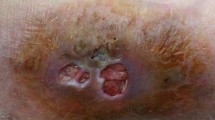Abstract
Phaeohyphomycosis is an infection caused by a heterogeneous group of melanized fungi. Human infections due to members of genus Exophiala are rare but may occur at any part of the body. We herein report a case of an 85-year-old male with a history of bullous pemphigoid who presented with a chronic, non-healing wound on his right dorsal hand for a month. Direct microscopy of a pus sample from the base of the ulcer revealed strands of pigmented, moniliform hyphae. The isolate was identified as E. oligosperma based on morphological characters and sequencing of the rDNA internal transcribed spacers (ITS) and partial beta-tubulin gene. The patient received a three-month course of oral itraconazole with no recurrence.


Similar content being viewed by others
References
Naggie S, Perfect JR. Molds: hyalohyphomycosis, phaeohyphomycosis, and zygomycosis. Clin Chest Med. 2009;30:337–53.
Matsumo T, Padhye AA, Ajello L. Medical significance of the so-called black yeast. Eur J Epidemiol. 1987;3:87–95.
De Hoog GS, Vicente VA, Caligiorne RB, et al. Species diversity and polymorphism in the Exophiala spinifera clade containing opportunistic black yeast-like fungi. J Clin Microbiol. 2003;41:4767–78.
Zeng JS, Sutton DA, Fothergill AW, et al. Spectrum of clinically relevant Exophiala species in the United States. J Clin Microbiol. 2007;45:3713–20.
Sun PL, Hsieh HM, Ju YM, et al. Molecular characterization of dermatophytes of the Trichophyton mentagrophytes complex found in Taiwan with emphasis on their correlation with clinical observations. Br J Dermatol. 2010;163:1312–8.
Zeng JS, Feng PY, Gerritis AHG, et al. Multilocus analysis of the Exophiala jeanselmei clade containing black yeasts involved in opportunistic disease in human. Fungal Divers. 2014;65:3–16.
Zen JS, De Hoog GS. Exophiala spinifera and its allies: diagnostics from morphology to DNA barcoding. Med Mycol. 2008;46:193–208.
Bossler AD, Richter SS, Chavez AJ, et al. Exophiala oligosperma causing olecranon bursitis. J Clin Microbiol. 2003;41:4779–82.
Al-Obaid I, Ahmad S, Khan ZU, et al. Catheter-associated fungemia due to Exophiala oligosperma in a leukemic child and review of fungemia cases caused by Exophiala species. Eur J Clin Microbiol Infect Dis. 2006;25:729–32.
González-López MA, Salesa R, González-Vela MC, et al. Subcutaneous phaeohyphomycosis caused by Exophiala oligosperma in a renal transplant recipient. Br J Dermatol. 2007;156:762–4.
Tokuhisa Y, Hagiya Y, Hiruma M, et al. Phaeohyphomycosis of the face caused by Exophiala oligosperma. Mycoses. 2011;54:e240–3.
Badali H, Hedayati MT, Bahoosh M, et al. Exophila oligosperma involved in a refractory chronic rhinosinusitis. Eur Rev Med Pharmacol Sci. 2011;15:319–23.
Kan T, Takahagi S, Kamegashira A, et al. Disseminated subcutaneous phaeohyphomycosis caused by Exophila oligosperma in a patient with Wegner’s granulomatosis. Acta Derm Venereol. 2013;93:356–7.
Fukai T, Hirma M, Ogawa Y, et al. A case of phaeohyphomycosis caused by Exophiala oligosperma successfully treated with local hyperthermia. Med Mycol J. 2013;54:297–301.
Sato T, Yaguchi T. A case of phaeohyphomycosis of the face caused by Exophiala oligosperma in an immunocompromised host. J Dtsch Dermatol Ges. 2013;11:1087–9.
Rimawi BH, Rimawi RH, Mirdamadi M, et al. A case of Exophila oligosperma successfully treated with voriconazole. Med Mycol Case Rep. 2013;8:144–7.
Woo PCY, Ngan AHY, Tsang CCC, et al. Clinical spectrum of Exophiala infections and a novel Exophiala species, Exophiala hongkongensis. J Clin Microbiol. 2013;51:260–7.
Venkateshwar S, Ambroise MM, Asir GJ, et al. A rare case report of subcutaneous phaeohyphomycotic cyst caused by Exophiala oligosperma in an immunocompetent host with literature review. Mycopathologia. 2014;178:117–21.
Levy AC, Rehman S, Sutton DS, et al. A case of phaeohyphomycosis caused by Exophila oligosperma in a renal transplant patient successfully treated with Posaconazole. Am J Infect Dis. 2015;11:15–9.
Wen YM, Rajendran RK, Lin YF, Kirshner R, Hu S. Onychomycosis associated with Exophila oligosperma in Taiwan. Mycopathologia. 2016;181:83–8.
Phoon YW, Fook-Chong SM, Koh HY, et al. Infectious complications in bullous pemphigoid: an analysis of risk factors. J Am Acad Dermatol. 2015;72:834–9.
Sugioura K, Sugiura N, Yagi T, et al. Cryptococcal cellulitis in a patient with bullous pemphigoid. Acta Derm Venereol. 2013;93:187–8.
Pereiro M Jr, Suarez I, Monteagudo B, et al. Alternariosis refractory to itraconazole in a patient suffering from bullous pemphigoid. Dermatology. 2001;202:268–70.
Zisova LG, Dobrev HP, Tchernev G, et al. Tinea atypica: report of nine cases. Wien Med Wochenschr. 2013;163:549–55.
Czernik A, Toosi S, Bystryn JC, et al. Intravenous immunoglobulin in the treatment of autoimmune bullous dermatoses: an update. Autoimmunity. 2012;45:111–8.
Hall TA. BioEdit: a user-firendly biological sequence alignment editor and analysis program for Windows 95/98/NT. Nucl Acids Symp Ser. 1999;41:95–8.
Author information
Authors and Affiliations
Corresponding author
Ethics declarations
Conflict of interest
The authors declare that they have no conflict of interest.
Rights and permissions
About this article
Cite this article
Ng, C.Y., de Hoog, S., Li, HE. et al. Cutaneous Exophiala oligosperma Infection in a Patient with Bullous Pemphigoid with a Review of the Literature. Mycopathologia 182, 539–547 (2017). https://doi.org/10.1007/s11046-016-0104-6
Received:
Accepted:
Published:
Issue Date:
DOI: https://doi.org/10.1007/s11046-016-0104-6




